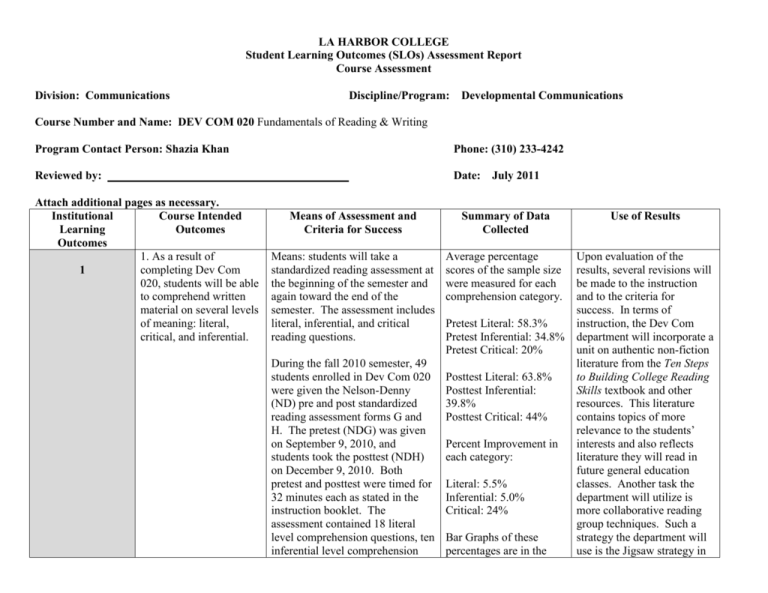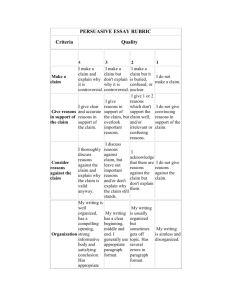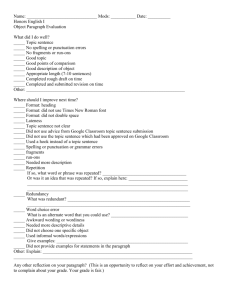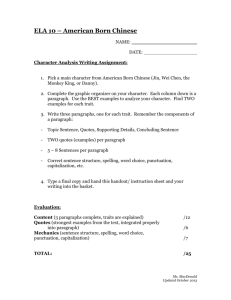LA HARBOR COLLEGE Student Learning Outcomes (SLOs
advertisement

LA HARBOR COLLEGE Student Learning Outcomes (SLOs) Assessment Report Course Assessment Division: Communications Discipline/Program: Developmental Communications Course Number and Name: DEV COM 020 Fundamentals of Reading & Writing Program Contact Person: Shazia Khan Phone: (310) 233-4242 Reviewed by: Date: July 2011 Attach additional pages as necessary. Institutional Course Intended Learning Outcomes Outcomes 1. As a result of completing Dev Com 1 020, students will be able to comprehend written material on several levels of meaning: literal, critical, and inferential. Means of Assessment and Criteria for Success Summary of Data Collected Use of Results Means: students will take a standardized reading assessment at the beginning of the semester and again toward the end of the semester. The assessment includes literal, inferential, and critical reading questions. Average percentage scores of the sample size were measured for each comprehension category. Upon evaluation of the results, several revisions will be made to the instruction and to the criteria for success. In terms of instruction, the Dev Com department will incorporate a unit on authentic non-fiction literature from the Ten Steps to Building College Reading Skills textbook and other resources. This literature contains topics of more relevance to the students’ interests and also reflects literature they will read in future general education classes. Another task the department will utilize is more collaborative reading group techniques. Such a strategy the department will use is the Jigsaw strategy in During the fall 2010 semester, 49 students enrolled in Dev Com 020 were given the Nelson-Denny (ND) pre and post standardized reading assessment forms G and H. The pretest (NDG) was given on September 9, 2010, and students took the posttest (NDH) on December 9, 2010. Both pretest and posttest were timed for 32 minutes each as stated in the instruction booklet. The assessment contained 18 literal level comprehension questions, ten inferential level comprehension Pretest Literal: 58.3% Pretest Inferential: 34.8% Pretest Critical: 20% Posttest Literal: 63.8% Posttest Inferential: 39.8% Posttest Critical: 44% Percent Improvement in each category: Literal: 5.5% Inferential: 5.0% Critical: 24% Bar Graphs of these percentages are in the questions, and ten critical level comprehension questions. With literal level questions, readers are asked to identify facts that are explicitly stated in the text. At the inferential level, readers make meaning from the text including meanings of unfamiliar words using context, drawing conclusions, and inferring. Finally, at the critical level, readers identify patterns of organization and the author’s purpose and bias. detailed report beginning on page 10. which students read short pieces of multi-topic nonfiction literature in small groups and then report to other groups as “experts” on what they have read. Techniques such as these will foster review of reading skills and summary among classmates. The department will also revise the criteria for success, because after further analysis, each percentage chosen to show improvement was not a reliable and realistic measure. Another method for measuring success may be to observe average growth in each comprehension category or grade level improvement. For either revision that is chosen, the department will consult the Institutional Research department frequently. Sample Size: 48 Even though more than 75% of the students accomplished the SLO, continuous Criteria: Students will show improvement as follows: -80% improvement in literal reading. -70% improvement in inferential reading -50% improvement in critical reading 1 1 2. As a result of completing Dev Com 020, students will be able to identify main ideas and major and minor supporting details in written material. 3. As a result of completing Dev Com 020, students will be able Means: Students will be given an exam with reading passages asking them to highlight/underline the main idea and list the major and minor supporting details. Criteria: 75% of students will earn a score of 70% or better. Means: Students will write 5 sentences demonstrating proper grammar, punctuation and Number and percentage to write sentences with minimum errors in grammar, punctuation and spelling. 1 4. As a result of completing Dev Com 020, students will be able to construct a paragraph containing a topic sentence and major and minor supporting details. spelling. On November 23, 2010, 48 students enrolled in Developmental Communications (Dev Com) 020 completed a takehome project which they were given one week prior. The project asked the students to write a descriptive paragraph using a cartoon provided by the instructor. The project was graded on the sequence and logic of the paragraph, number of complete sentences, spelling, grammar, and punctuation. The assignment description and grading rubric are below. Criteria: 75% of students will earn a score of 70% or better scored according to a department rubric. Means: Students will write a paragraph containing a topic sentence, and major and minor supporting details. On December 9, 2010, 27 students enrolled in Dev Com 020 completed a second take-home writing project which they were given a week prior to the due date. The project asked students to respond to a prompt provided by the instructor. The project was graded on the quality of the topic sentence, major and minor supporting details, conclusion sentence, and grammar and punctuation. The assignment of students with scores ≥ 70% (43 ≈ 89.5%) Number and percentage of students with score < 70% (4 ≈ 8.3%) Sample Size: 27 Number and percentage of students with scores ≥ 70% (20 ≈ 74%) Number and percentage of students with score < 70% (7 ≈ 26%) assessment will be done and strategies and materials will be explored to further improve upon instruction in this area. Upon evaluation of the results, the plan to assist students to achieve this SLO will be to revise the instructional method and means of assessment. In order to revise the method of instruction, the instructor will utilize the paragraphwriting assignments connected to the articles included in the class textbook, 10 Steps to Building College Reading Skills. This will allow the measurement of the assessment to be further revised by observing students’ paragraph writing improvement several times throughout the semester. description and grading rubric are below. The results of the including a proper topic sentence and adequate major and minor supporting details are only described in the Summary of Data Collected to show achievement of the SLO. Criteria: 75% of students will earn a score of 70% or better according to a department rubric. Dev Com 020 SLO Report Fall 2010 1. SLO #3: students will write sentences with minimum errors in grammar, spelling, and punctuation. Assessment: On November 23, 2010, 48 students enrolled in Developmental Communications (Dev Com) 020 completed a take-home project which they were given one week prior. The project asked the students to write a descriptive paragraph using a cartoon provided by the instructor. The project was graded on the sequence and logic of the paragraph, number of complete sentences, spelling, grammar, and punctuation. The assignment description and grading rubric are below. Dev Com 20 Writing Project: Grammar & Punctuation Description: You will write a descriptive paragraph on the cartoon attached to this sheet. You will describe the events in order shown in the cartoon. Feel free to use your imagination and creativity as long as it logically supports the content of the cartoon. The grade for this paragraph will be based on the following rubric. Other Requirements: Your paragraph must be indented, typed, and double-spaced with 12 size font. Your name, class (Dev Com 020), and the date must appear in the top left-hand corner. Your paper will not be accepted if these two conditions are not met. Excellent (5 Points) Above Average (4 Points) Average (3 Points) Below Average (1-2 Points) Unacceptable (0 Points) Sentences describe the cartoon in order and contain ideas that logically support the cartoon. Paragraph includes at least 5 complete sentences. Sentences describe the cartoon in order, but fail to describe the point of the cartoon. Spelling Paragraph has very few, if any, spelling errors. Paragraph has some spelling errors, but do not significantly interfere with the readability. Grammar Subject/verb agreement Pronoun form Verb from Paragraph has very few, if any, grammatical errors. Paragraph contains grammatical errors, but do not interfere significantly with the readability. Punctuation Complete thoughts with subject Paragraph has very few, if any, punctuation Paragraph contains punctuation related errors, Sequence & Logic Number of Complete Sentences Paragraph contains four complete sentences Sentences describe the cartoon in partial order and do not include the main point of the cartoon. Paragraph contains three complete sentences There is little logic and description of events is weak. Paragraph contains only one to two complete sentences. Paragraph Paragraph contains contains spelling errors spelling that interfere errors that with confuse readability of meaning some of the and logic of descriptions of the events. cartoon’s events. Grammatical Grammatica errors interfere l errors with significantly readability of interfere some of the with descriptions of understandi events. ng the sequence and logic of events. Punctuation Punctuation errors impair errors some of the significantly understanding impair There is no logic and events are presented out of order. Paragraph lacks any complete sentences. Contains a large amount of spelling errors. Majority of paragraph contains grammatical errors. Majority of the paragraph inconsistently follows rules of and verb No run-ons No fragments End punctuation related errors. but do not interfere significantly with the readability. of the description and logic of events. understandi ng of the events of the cartoon. punctuation. Criteria for Success: 75% of students will earn a score of 70% or better scored according to a department rubric. Summary of Data Collected: Sample Size Number & Percentage of Scores ≥ 70% Number & Percentage of Scores < 70% 48 43 ≈ 89.5% 4 ≈ 8.3% Use of Results: Even though more than 75% of the students accomplished the SLO, continuous assessment will be done and strategies and materials will be explored to further improve upon instruction in this area. 2. SLO #4: students will construct a paragraph containing a topic sentence, and major and minor supporting details. Assessment: On December 9, 2010, 27 students enrolled in Dev Com 020 completed a second take-home writing project which they were given a week prior to the due date. The project asked students to respond to a prompt provided by the instructor. The project was graded on the quality of the topic sentence, major and minor supporting details, conclusion sentence, and grammar and punctuation. The assignment description and grading rubric are below. The results of the including a proper topic sentence and adequate major and minor supporting details are only described in the Summary of Data Collected to show achievement of the SLO. Dev Com 020 Writing Assignment #2: Paragraph Writing Due Date: Thursday, December 9, 2010 Description: You will write a paragraph on the prompt below. Prompt: Now that you have taken and almost completed Dev Com 020, it is time for self-reflection. Write one paragraph on what you have accomplished, achieved, and/or learned as a result of Dev Com 020. Include major supporting details and examples to illustrate and explain your major supporting details. Requirements: The paragraph you write must contain the following: 1. 2. 3. 4. 5. 6. 7. an appropriate title before your paragraph begins one topic sentence at the beginning of the paragraph at least three major supporting details at least one to two minor supporting details for each major supporting detail transition words connecting the supporting details (first, second, third, finally, …) a conclusion sentence that does not restate the topic sentence word for word proper spelling, punctuation, capitalization, grammar, and vocabulary Document Design: 1. typed and double-spaced 2. 12-point font 3. Title must be centered 4. Name, class information (Dev Com 020), and date must appear in the top left-hand corner Suggestions: Before you begin to write, use the questions below to guide you. 1. What three or four things have I learned in Dev Com 020? 2. What is an example or two for each item that I have learned? 3. What areas do I feel have I improved in the most? 4. What example can I use to show the improvement? Paragraph Writing Project Grading: the grade of your final draft will be based on the rubric below. Topic Sentence Supporting Details Conclusion Writing & Document Design 5 points 4 Points 3 points The paragraph has a clear topic sentence that refers to the main idea of the question or assigned topic. The paragraph contains at least five sentences that support the main idea with reasons, details or facts. The topic sentence contains the main idea of the question or assigned topic. The topic sentence is relatively clear and addresses the main point fairly well. The paragraph contains a few supporting sentences that support the main idea. Inadequate topic sentence or lack of one. The conclusion repeats the introduction. There is no evidence of a conclusion. Some spelling, punctuation and capitalization errors occur that detract from the overall quality of the essay. Occasional grammar errors. Vocabulary words are misused or inaccurate. Frequent misspelled words, misused or missing punctuation and capitalization greatly detract from the overall quality and understanding of the paragraph. Frequent grammar errors. Vocabulary words are misused. No evidence of The details are well organized, interesting and elaborate on the main topic of the paragraph. The conclusion closes the paragraph and refers to the main idea without repeating it. Demonstrates correct spelling, punctuation and capitalization. Precise use of grammar and vocabulary. Document is properly designed. (title, doublespaced, 12-point font, name/class information formatting) The paragraph contains at least three supporting sentences. The details in these sentences elaborate on the main topic fairly well. The conclusion wraps up the paragraph fairly well and refers to the main idea. Spelling, punctuation and capitalization errors occur but do not detract from the overall quality of the essay. Contains some minor grammar errors. Few vocabulary words are misused or inaccurate. 1-2 points The paragraph contains few or none supporting sentences. Evidence of revision and proofreading is obvious. One or more mistakes are made in formatting. Evidence of revision and proofreading is less apparent. Two or more mistakes are made in formatting. revision and proofreading. Formatting is incorrect. Criteria for Success: 75% of students will earn a score of 70% or better according to a department rubric. Summary of Data Collected: Sample Size 27 Number & Percentage of Scores ≥ 70% 20 ≈ 74% Number & Percentage of Scores < 70% 7 ≈ 26% Use of Results: Upon evaluation of the results, the plan to assist students to achieve this SLO will be to revise the instructional method and means of assessment. In order to revise the method of instruction, the instructor will utilize the paragraph-writing assignments connected to the articles included in the class textbook, 10 Steps to Building College Reading Skills. This will allow the measurement of the assessment to be further revised by observing students’ paragraph writing improvement several times throughout the semester. 3. SLO #1: students will comprehend written material on several levels of meaning: literal, inferential, and critical. Assessment: During the fall 2010 semester, 49 students enrolled in Dev Com 020 were given the Nelson-Denny (ND) pre and post standardized reading assessment forms G and H. The pretest (NDG) was given on September 9, 2010, and students took the posttest (NDH) on December 9, 2010. Both pretest and posttest were timed for 32 minutes each as stated in the instruction booklet. The assessment contained 18 literal level comprehension questions, ten inferential level comprehension questions, and ten critical level comprehension questions. With literal level questions, readers are asked to identify facts that are explicitly stated in the text. At the inferential level, readers make meaning from the text including meanings of unfamiliar words using context, drawing conclusions, and inferring. Finally, at the critical level, readers identify patterns of organization and the author’s purpose and bias. Criteria for Success: Students will show improvement as follows: 80% improvement in literal reading 70% improvement in inferential reading 50% improvement in critical reading Summary of Data Collected: Each chart above shows the average percentage correct from each category of comprehension. In each category, students made the following improvements: Literal: 5.5% Inferential: 5.0% Critical: 24% Use of Results: Upon evaluation of the results, several revisions will be made to the instruction and to the criteria for success. In terms of instruction, the Dev Com department will incorporate a unit on authentic non-fiction literature from the Ten Steps to Building College Reading Skills textbook and other resources. This literature contains topics of more relevance to the students’ interests and also reflects literature they will read in future general education classes. Another task the department will utilize is more collaborative reading group techniques. Such a strategy the department will use is the Jigsaw strategy in which students read short pieces of multi-topic non-fiction literature in small groups and then report to other groups as “experts” on what they have read. Techniques such as these will foster review of reading skills and summary among classmates. The department will also revise the criteria for success, because after further analysis, each percentage chosen to show improvement was not a reliable and realistic measure. Another method for measuring success may be to observe average growth in each comprehension category or grade level improvement. For either revision that is chosen, the department will consult the Institutional Research department frequently.









